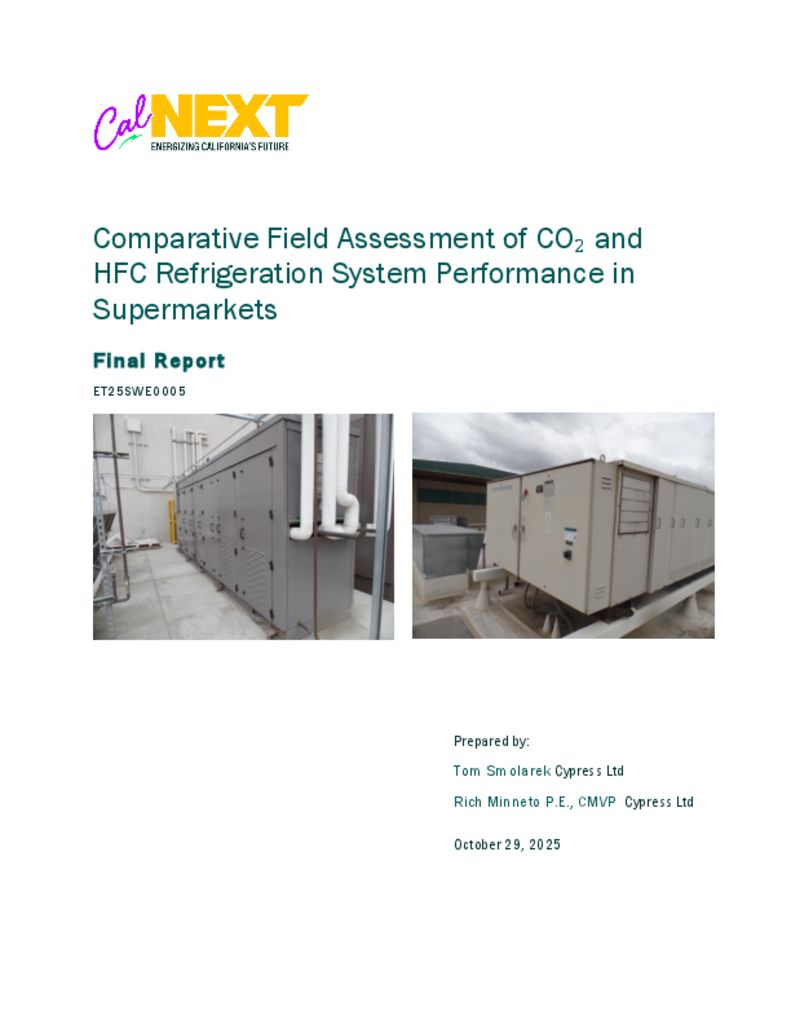ET25SWE0005 - Comparative Field Assessment of CO₂ System Performance vs. HFC Refrigeration in Supermarkets
Refrigeration systems in commercial facilities, such as supermarkets and grocery stores refrigerated display cases and cooler/freezer rooms, can account for up to 50% of these facilities' total electricity consumption. In California, most refrigeration systems rely on HydroFluoroCarbon (HFCs), which have high global warming potential (GWP). With increasing regulatory and policy pressure, the demand for California's refrigeration end-users to transition to low-GWP refrigerants is growing. However, there are limited field assessments that focus on the use of CO₂ for commercial refrigeration in grocery stores. It is important for customers to understand the CO₂ system’s performance including energy and demand use.
The previous lab assessment (ET19SCE7070), conducted by SCE, produced positive results for a small CO₂ system, supporting the need for this field assessment to evaluate energy savings and operational benefits at much larger actual customer sites. This proposed project will compare CO2 to HFC based refrigeration in at least two California Climate Zones (CZ), gather required operational data to analyze the unit’s performance, and obtain customer feedback on the use of CO₂ as a refrigerant.
While CO₂ refrigeration is gaining traction among some key customers due to the need to avoid high-GWP refrigerants, it still lags the use of traditional refrigerants. This project will deepen the understanding of the energy and operational benefits of CO₂ system refrigeration refrigerated cases and multiplex rack systems at the selected customer sites at one of the largest national grocery store chains and identify market barriers and inform utility programs.
This assessment will focus on CO₂ as the refrigerant. The project will conduct stakeholder meetings, recruit locations, conduct site selections and audits, evaluate the requirements and specifications of the customer’s refrigeration systems, select the sites, perform (M&V) and report the results and recommendations. Customer/stakeholder feedback will also be gathered to help inform utility efforts to increase market adoption of CO₂ refrigeration systems in the retail food refrigeration market. This project’s focus on (CO₂) systems aligns directly with the listed 2024 Process Loads TPM Refrigeration- Commercial area, where ETP has the lead role and the priority is high. The sub-family Refrigeration, Commercial & Industrial lists the proposed Research Initiative as having immediate need for performance evaluation.
The project team anticipates that the utility program teams will have no significant challenges in using the data from this project to support future or existing custom incentive programs, as has been done with previous field assessments. Additionally, there is a separate CalNEXT project (ET24SWE0046) underway that updates and refines existing CO₂ analysis and load modeling tools to support utility programs.
Key objectives:
- Field assessment and performance comparison of CO₂ and standard HFC refrigerant units in at least two climate zones (CZs).
- Obtain performance results for the selected systems and determine the benefits of CO₂ systems in retail food refrigeration.
- Review market barriers and feedback from stakeholders.
- Compare the assessed CO₂ systems to a previous lab report as applicable.
- Interview stakeholders on market size, adoption barriers, estimated return on investment (ROI), and end-use market considerations that could impact future market penetration.
California regulations limiting the use of refrigerants with global warming potential (GWP) greater than 150 have accelerated supermarket adoption of CO₂ (R-744) transcritical refrigeration systems. However, limited empirical data exist on system performance in California’s diverse climate zones. This study compares field performance of two CO₂ and two HFC (R-404A) supermarket refrigeration systems located in Climate Zones 10 and 11.
Four months of high-resolution monitored data were collected using calibrated three-phase power meters and temperature loggers. Regression models were developed to characterize refrigeration energy use as a function of outdoor air temperature, and annualized performance was estimated using typical meteorological year (TMY) weather data. Site personnel interviews were conducted to supplement measured results with operational observations.
Results indicate that CO₂ systems demonstrated no measurable energy advantage over HFC systems in the warm climate zones studied. Installation costs for CO₂ systems were approximately 30% higher than HFC systems. Annual refrigerant leak rates of 7–19% were observed at CO₂ sites; however, associated greenhouse gas emissions were negligible due to the low GWP of R-744. CO₂ systems exhibited greater operational sensitivity to ambient conditions and increased complexity during restart events.
Overall, study findings suggest that CO₂ system adoption in warm climates is driven primarily by refrigerant regulatory compliance and corporate GHG reduction goals rather than energy or cost savings. Additional field studies across multiple California climate zones are recommended to support the development of incentive structures and to better characterize performance, reliability, and refrigerant leakage profiles.

